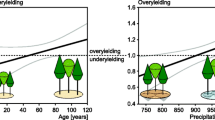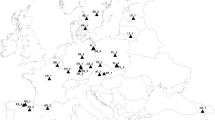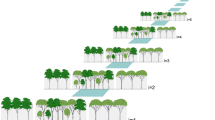Abstract
The mixture of beech (Fagus sylvatica L.) and oak (sessile oak, Quercus petraea (Matt.) Liebl., and pedunculate oak, Q. robur L.) is of considerable importance in Europe and will probably become even more important under climate change. Therefore, the performance of oak and beech in mixture was compared with the species’ growth in pure stands. Data from 37 long-term mixing experiments in Poland, Germany and Switzerland were pooled for analysis of mixing effects on stand productivity and possible interrelationships with mixing portions or site conditions. We found that on average, mixed stands of oak and beech exceeded biomass productivity in pure stands by 30 % or 1.7 t ha−1 year−1, as the growth of both species was benefitted by the mixture. However, that the interaction actually ranged from facilitation and overyielding on poor sites to underyielding on fertile sites triggered by competition. An empirically derived interaction model showed volume and dry mass growth changing in mixed stands from gains of 50 % to losses of 10 % depending on site conditions. It is concluded that the analysed mixture grows in accordance with the stress-gradient hypothesis and that our results suggest a site-specific relationship between species mixture and biomass productivity. As a consequence, an adequate species mix should result in increased productivity under steady state as well as climate change.









Similar content being viewed by others
References
Aas G (2000) Quercus petraea (Matt.) Liebl., Traubeneiche. In: Roloff A, Weisgerber H, Lang UM, Stimm B (eds) Enzyklopädie der Holzgewächse: 1–15. Wiley-VCH, Weinheim
Aas G (2002) Quercus robur L., Stieleiche. In: Roloff A, Weisgerber H, Lang UM, Stimm B (eds) Enzyklopädie der Holzgewächse. Wiley-VCH, Weinheim, pp 1–15
André F, Jonard M, Ponette Q (2008) Spatial and temporal patterns of throughfall chemistry within a temperate mixed oak-beech stand. Sci Total Environ 397:215–228
Aranda I, Gil L, Pardos J (1996) Seasonal water relations of three broadleaved species (Fagus sylvatica L., Quercus petraea (Mattuschka) Liebl. and Quercus pyrenaica Willd.) in a mixed stand in the centre of the Iberian Peninsula. For Ecol Manage 84:219–229
Assmann E (1961) Waldertragskunde. Organische Produktion, Struktur, Zuwachs und Ertrag von Waldbeständen. BLV Verlagsgesellschaft, München, Bonn, Wien, 490 p
Augusto L, Ranger J, Binkley D, Rothe A (2002) Impact of several common tree species of European temperate forests on soil fertility. Ann For Sci 59:233–253
Binkley D, Stape JL, Ryan MG (2004) Thinking about efficiency of resource use in forests. For Ecol Manage 193:5–16
Bohn U, Gollup G, Hettwer C, Neuhäuslova Z, Schlüter H (2003) Map of the natural vegetation of Europe, scale 1: 2.5 million. Federal Agency for Nature Conservation, Bonn-Bad Godesberg
Breda N (2003) Ground-based measurements of leaf area index: a review of methods, instruments and current controversies. J Exp Bot 54:2403–2417
Burschel P, Kürsten E, Larson BC (1993) Die Rolle von Wald und Forstwirtschaft im Kohlenstoffhaushalt. Forstl Forschungsber München 126, 135 p
Caldwell MM, Dawson TE, Richards JH (1998) Hydraulic lift: consequences of water efflux from the roots to plants. Oecologia 113:151–161
Callaway RM, Walker LR (1997) Competition and facilitation: a synthetic approach to interactions in plant communities. Ecology 78(7):1958–1965
Dawson TE (1993) Hydraulic lift and water use by plants: implications for water balance, performance and plant-plant interactions. Oecologia 95:565–574
Ellenberg H, Leuschner Ch (2009) Vegetation Mitteleuropas mit den Alpen in ökologischer, dynamischer und historischer Sicht. Verlag Eugen Ulmer, Stuttgart 1334 p
Epron D, Dreyer E (1993) Long-term effects of drought on photosynthesis of adult oak trees (Quercus petraea (Matt.) Liebl. and Quercus robur L.) in a natural stand. New Phytol 125:381–389
FAWF (2011a) Forschungsanstalt für Waldökologie und Forstwirtschaft Rheinland-Pfalz, Depositionsmessungen im forstlichen Umweltmonitoring. http://www.fawf.wald-rlp.de/fileadmin/website/fawfseiten/fawf/FUM/index.htm?umweltmonitoring/deposition.html
FAWF (2011b) Forschungsanstalt für Waldökologie und Forstwirtschaft Rheinland-Pfalz, Steufallmessungen im forstlichen Umweltmonitoring. http://www.fawf.wald-rlp.de/fileadmin/website/fawfseiten/fawf/FUM/index.htm?umweltmonitoring/DBFL/forschung.html
Fischer A, Fischer H (2012) Restoration of temperate forests: an European approach. In: van Andel J, Aronson J (eds) Restoration ecology: the new Frontier, 2nd edn. Blackwell publishing Ltd, Oxford, pp 145–160
Fölster H, Degenhardt M, Flor T, Lux M (1991) Untersuchungen zur Tiefendurchwurzelung und Durchwurzelungsintensität auf Braunerde-Pseudogleyen im Vorderen Hunsrück in Abhängigkeit von Baumart und Bestandesstrukturparametern. Mitteilungen aus der Forstl. Versuchsanstalt Rheinland-Pfalz 19(91):91–106
Forrester DI, Bauhus J, Cowie AL, Vanclay JK (2006) Mixed-species plantations of Eucalyptus with nitrogen-fixing trees: a review. For Ecol Manage 233:211–230
Forrester DI, Bauhus J, Cowie AL, Mitchell PA, Brockwell J (2007) Productivity of three young mixed-species plantations containing N2-fixing Acacia and non-N2-fixing Eucalyptus and Pinus trees in Southeastern Australia. For Sci 53(3):426–434
Ganghofer von A (1881) Das Forstliche Versuchswesen, Augsburg, 1881, 505 p
Griess VC, Knoke Th (2011) Growth performance, windthrow, and insects: meta-analyses of parameters influencing performance of mixed-species stands in boreal and northern temperate biomes. Can J For Res 41:1141–1158
Harper JL (1977) Population biology of plants. Academic Press, London, NY, p 892
Hausrath H (1927) Versammlung des Vereins der Deutschen Forstlichen Versuchsanstalten in Rostock. Allg. Forst- u. J.-Ztg 103:73–77
Hector A, Schmid B, Beierkuhnlein C, Caldeira MC, Diemer M, Dimitrakopoulus PG, Finn JA, Freitas H, Giller PS, Good J, Harris R, Högberg P, Huss-Danell K, Joshi J, Jumpponen A, Körner C, Leadley PW, Loreau M, Minns A, Mulder CPH, O’Donovan G, Otway SJ, Pereira JS, Prinz A, Read DJ, Scherer-Lorenzen M, Schulze ED, Siamantziouras ASD, Spehan EM, Terry AC, Troumbis AY, Woodward FI, Yachi S, Lawton JH (1999) Plant diversity and productivity experiments in European grasslands. Science 286:1123–1127
Hein S, Dhôte JF (2006) Effect of species composition, stand density and site index on the basal area increment of oak trees (Quercus sp.) in mixed stands with beech (Fagus sylvatica L.) in northern France. Ann For Sci 63:457–467
Holmgren M, Scheffer M, Huston MA (1997) The interplay of facilitation and competition in plant communities. Ecology 78(7):1966–1975
Huntley B (1988) European post-glacial vegetation history: a new perspective. In: Quellet H (ed) Acta XIX Congressus Internalis Ornithologici vol 1. National Museum of Natural Sciences, Ottawa, pp 1061–1077
Jensen AM (1983) Ædelgranens (Abies alba Mill.) vækst sammenlignet med rødgranens (Picea abies (L) Karst.) i henholdsvis rene og blandede bevoksninger på sandede jorder i Midt- og Vestjylland. (Growth of Silver Fir (Abies alba Mill.) compared with the growth of Norway Spruce (Picea abies (L) Karst.) in pure and mixed stands on sandy soils in the Western parts of Denmark). Meddelelser fra Skovbrugsinstituttet, No. 14, Royal Veterinary and Agricultural University, Copenhagen, Department of Forestry, 498 p
Johann K (1993) DESER-Norm 1993. Normen der Sektion Ertragskunde im Deutschen Verband Forstlicher Forschungsanstalten zur Aufbereitung von waldwachstumskundlichen Dauerversuchen. Proc Dt Verb Forstl Forschungsanst, Sek Ertragskd, in Unterreichenbach-Kapfenhardt, pp 96–104
Jonard M, André F, Ponette Q (2008) Tree species mediated effects on leaf litter dynamics in pure and mixed stands of oak and beech. Can J For Res 38:528–538
Jüttner O (1955) Eichenertragstafeln. In: Schober R (ed) (1971) Ertragstafeln der wichtigsten Baumarten. JD Sauerländer’s Verlag, Frankfurt am Main, pp 12–25, 134–138
Kelty MJ (1992) Comparative productivity of monocultures and mixed stands. In: Kelty MJ, Larson BC, Oliver CD (eds) The ecology and silviculture of mixed-species forests. Kluwer Academic Publishers, Dordrecht, pp 125–141
Kenk G, Guehne S (2001) Management of transformation in Central Europe. For Ecol Manage 151:107–119
Kennel R (1965) Untersuchungen über die Leistung von Fichte und Buche im Rein- und Mischbestand. AFJZ 136(149–161):173–189
Knigge W, Schulz H (1966) Grundriss der Forstbenutzung. Verlag Paul Parey, Hamburg, 584 p
Kölling C, Zimmermann L (2007) Die Anfälligkeit der Wälder Deutschlands gegenüber dem Klimawandel. Gefahrstoffe-Reinhaltung der Luft 67(6):259–268
Körner C (2002) Ökologie. In: Sitte P, Weiler EW, Kadereit JW, Bresinsky A, Körner C (eds) Strasburger Lehrbuch für Botanik, 35th edn. Spektrum Akademischer Verlag, Heidelberg, pp 886–1043
Kremer A, Petit RJ, Ducousso A (2002) Biologie évolutive et diversité génétique des chênes cessile et pédonculé. Rev For Fr LIV 111–130
Lang G (1994) Quartäre Vegetationsgechichte Europas. Verlag G. Fischer
Leibundgut H (1987) Ziele und Wege der naturnahen Waldwirtschaft Schweiz. Z. Forstwes 137:245–250
Leuschner C (1998) Mechanismen der Konkurrenzüberlegenheit der Rotbuche. Ber Reinh Tüxen Ges 10:5–18
Leuschner Ch, Hertel D, Coners H, Büttner V (2001) Root competition between beech and oak: a hypothesis. Oecologia 126:267–284
Levy G, Becker M, Duhamel D (1992) A comparison of the ecology of pedunculate and sessile oaks: radial growth in the centre and northwest of France. For Ecol Manage 55:51–63
Lyr H, Polster H, Fiedler HJ (1967) Gehölzphysiologie. VEB Gustav Fischer Verlag, Jena 337 p
Mantel W (1961) Wald und Forst. Wechselbeziehungen zwischen Natur und Wirtschaft, Rowohlts deutsche Enzyklopädie. Rowohlt, Hamburg
Manthey M, Leuschner C, Härdtle W (2007) Buchenwälder und Klimawandel. Natur und Landschaft 82(9/10):441–445
Matyssek R, Fromm J, Rennenberg H, Roloff A (2010) Biologie der Bäume. UTB Verlag Eugen Ulmer, Stuttgart, 349 p
Mayer H (1984) Wälder Europas. Gustav Fischer Verlag, Stuttgart, NY, p 691
Meinen C, Leuschner CH, Ryan NT, Hertel D (2009) No evidence of spatial root system segregation and elevated fine root biomass in multi-species temperate broad-leaved forests. Trees 23:941–950
Morin X, Fahse L, Scherer-Lorenzen M, Bugmann H (2011) Tree species richness promotes productivity in temperate forests through strong complementarity between niches. Ecol Lett. doi:10.1111/j.1461-0248.2011.01691.x,2011
Pretzsch H (1999) Waldwachstum im Wandel, Konsequenzen für Forstwissenschaft und Forstwirtschaft. Forstw Cbl 118:228–250
Pretzsch H (2003) Diversität und Produktivität von Wäldern. Allg. Forst- u. J.-Ztg. 174: 88–98
Pretzsch H, Dieler J (2012) Evidence of variant intra- and interspecific scaling of tree crown structure and relevance for allometric theory. Oecologia 169(3):637–649. doi:10.1007/s00442-011-2240-5
Pretzsch H, Ďurský J (2002) Growth response of Norway spruce (Picea abies (L.) Karst) upon expected climatic changes in Germany, In: Pretzsch et al. (ed) German forest sector under global change an interdisciplinary impact assessment, German. J For Sci 121(1):145–154
Pretzsch H, Block J, Dieler J, Dong PH, Kohnle U, Nagel J, Spellmann H, Zingg A (2010) Comparison between the productivity of pure and mixed stands of Norway spruce and European beech along an ecological gradient. Ann For Sci 67(7):p712. doi:10.1051/forest/2010037
Pretzsch H, Schütze G, Uhl E (2012) Resistance of European tree species to drought stress in mixed versus pure forests: evidence of stress release by inter-specific facilitation. Plant Biol. doi:10.1111/j.1438-8677.2012.00670.x
Rennenberg H, Seiler W, Matyssek R, Gessler A, Kreuzwieser J (2004) Die Buche (Fagus sylvatica L.)—ein Waldbaum ohne Zukunft im südlichen Mitteleuropa?. Allg. Forst- u. J.-Ztg. 175(10/11):210–224
Richards AE, Forrester DI, Bauhus J, Scherer-Lorenzen M (2010) The influence of mixed tree plantations on the nutrition of individual species: a review. Tree Physiol. doi:10.1093/treephys/tpq035
Roloff A, Bärtels A (2008) Flora der Gehölze. Ulmer, Stuttgart, p 853
Sariyildiz T, Anderson JM (2003) Interactions between litter quality, decomposition and soil fertility: a laboratory study. Soil Biol Biochem 35(3):391–399
Scherer-Lorenzen M, Körner C, Schulze ED (2005) Forest diversity and function. Ecol studies 176. Springer, Heidelberg, 399 p
Schober R (1967) Buchen-Ertragstafel für mäßige und starke Durchforstung. In: Die Rotbuche 1971, J. D. Sauerländer’s Verlag, Frankfurt a. Main, 1972, Schriften aus der Forstlichen Fakultät der Universität Göttingen und der Niedersächsischen Forstlichen Versuchsanstalt 43/44
Schütz JP (1999) Close-to-nature silviculture: is this concept compatible with species diversity? Forestry 72:359–366
Spellmann H, Albert M, Schmidt M, Sutmöller J, Overbeck M (2011) Waldbauliche Anpassungsstrategien für veränderte Klimaverhältnisse. AFZ-DerWald 66(11):19–23
Talkner U, Jansen M, Beese FO (2009) Soil phosphorus turnover in Central European beech forest ecosystems with differing tree species diversity. Eur J Soil Sci 60:338–346
Tyler G (1992) Tree species affinity of decomposer and ectomycorrhizal macrofungi in beech (Fagus silvatica L.), oak (Quercus robur, L.) and hornbeam (Carpinus betulus L.) forests. For Ecol Manage 47:269–284
Valladares F, Chico JM, Aranda I, Balaguer L, Dizengremel P, Manrique E, Dreyer E (2002) The greater seedling high-light tolerance of Quercus robur over Fagus sylvatica is linked to a greater physiological plasticity. Trees 16:395–403
Vandermeer J (1989) The ecology of intercropping. Cambridge University Press, UK, 237 p
Verein Deutscher Forstlicher Versuchsanstalten (1902) Beratungen der vom Vereine Deutscher Forstlicher Versuchsanstalten eingesetzten Kommission zur Feststellung des neuen Arbeitsplanes für Durchforstungs- und Lichtungsversuche. Allg. Forst- u. J.-Ztg. 78:180–184
Wiedemann E (1942) Der Eichenbestand mit Buchenunterwuchs. Zeitschrift für Forst- und Jagdwesen 74:305–335
Wiedemann E (1951) Ertragskundliche und waldbauliche Grundlagen der Forstwirtschaft. JD Sauerländer‘s Verlag, Frankfurt am Main, 346 p
Acknowledgments
Thanks to Gregor Aas, Ecological-Botanical Garden, University of Bayreuth, for his advice how to deal with the two different Quercus species in this evaluation and to Anton Fischer, Geoecology, Technische Universität München, for revision of the geoecological statements on oak and beech. We further wish to thank the German Science Foundation (Deutsche Forschungsgemeinschaft) for providing the funds for mixed stand research as part of the Collaborative Research Centre 607 (Sonderforschungsbereich SFB 607) “Growth and Parasite Defense” and the Bavarian State Ministry for Nutrition, Agriculture and Forestry for permanent support of the project W 07 “Long-term experimental plots for forest growth and yield research.” The included mixed stand trials belong to the networks of long-term experimental plots in Switzerland, Poland and Germany, and we are deeply grateful to the respective sponsoring forest administrations. Thanks are also due to Ulrich Kern for the graphical artwork.
Author information
Authors and Affiliations
Corresponding author
Additional information
Communicated by R. Matyssek.
Electronic supplementary material
Below is the link to the electronic supplementary material.
Rights and permissions
About this article
Cite this article
Pretzsch, H., Bielak, K., Block, J. et al. Productivity of mixed versus pure stands of oak (Quercus petraea (Matt.) Liebl. and Quercus robur L.) and European beech (Fagus sylvatica L.) along an ecological gradient. Eur J Forest Res 132, 263–280 (2013). https://doi.org/10.1007/s10342-012-0673-y
Received:
Revised:
Accepted:
Published:
Issue Date:
DOI: https://doi.org/10.1007/s10342-012-0673-y




